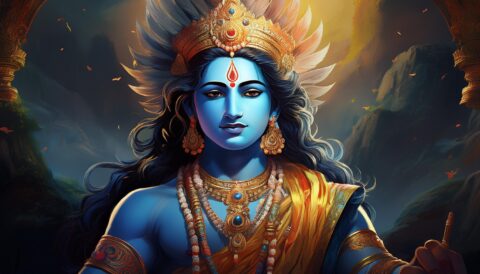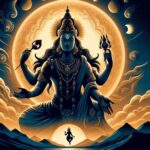While Krishna’s early life was filled with divine playfulness and eternal love which is well known, his position in the epic Mahabharata was equally profound and significant. It was during this time that his heavenly nature and wisdom are most visible. Krishna’s involvement in the Mahabharata begins well before the epic war. He was essential in averting a great fight between the Kauravas and Pandavas. He used diplomacy and counsel to avoid the impending battle, but when peace was unattainable, he supported the Pandavas, who were righteous. Krishna, as Arjuna’s charioteer, played an important role in the Kurukshetra War. His leadership and heavenly wisdom, provided in the Bhagavad Gita, encouraged Arjuna to carry out his military duties.
Krishna’s function was more than just a charioteer; he was Arjuna’s spiritual instructor, confidant, and celestial protector. He demonstrated unrivaled divine abilities, slaying formidable fighters such as Bhishma, Karna, and Shalya. His interventions are critical to turning the balance in favor of the Pandavas. However, Krishna’s significance in the Mahabharata extends beyond combat. He is known as the builder of peace and reconciliation. Following the conflict, he plays an important part in restoring order and establishing the Pandavas’ rule. His skill and diplomacy help to unite the divided kingdom. Krishna’s life, especially his participation in the Mahabharata, demonstrates his varied nature. He is the divine lover, the greatest philosopher, the bravest warrior, and the wisest politician. His acts and teachings continue to inspire and lead people today, making him one of the most respected characters in the Hindu pantheon.
The Architect of Victory
As Arjuna’s charioteer, Krishna’s strategic ability was on full show. His function was far more than simply driving the chariot. He was the strategist of the Pandavas’ successes. Understanding the combat: Krishna had a remarkable capacity to appraise combat conditions, identify vulnerabilities, and design counterstrategies. Leveraging supernatural talents: He smoothly combined supernatural talents with human strategies, transforming him into an unstoppable force. Beyond physical prowess, Krishna excelled in psychological warfare. His words could inspire confidence, instill mistrust in opponents, and manipulate events to his benefit.
Krishna’s Other Divine Armaments
While the Sudarshana Chakra is unquestionably Krishna’s most iconic weapon, he wielded a variety of celestial armaments, each with its own power and meaning.
Kaumodaki, the Mace of Invincible Might
Kaumodaki is Krishna’s celestial mace, a powerful weapon famed for its destructive abilities. It is generally pictured as a massive club with exquisite carvings. Krishna utilized this mace to defeat demons and formidable opponents. Its sheer heft and weight rendered it a lethal weapon in close battle.
Sharanga – The Divine Bow
Sharang, Krishna’s bow, was a celestial weapon with enormous power. Vishwakarma claimed it was indestructible and capable of firing arrows with extraordinary speed and accuracy. With Sharanga, Krishna could fire a torrent of divine arrows.
Panchajanya, the Conch Shell
Panchajanya, while not a weapon in the usual sense, is a valuable instrument in Krishna’s arsenal. This holy conch shell produced a strong sound that could demoralize opponents while inspiring comrades. Its resonant tone was said to have the ability to shake the earth and sky.
These are only a few of the divine weapons linked with Krishna. Each weapon represents a unique facet of his almighty strength and personality. Together, they comprise a fearsome arsenal that highlights his role as the universe’s protector.
Krishna’s Departure: Philosophical Perspective
Krishna’s departure, commonly known as ‘nirvana,’ provides significant philosophical insights. It represents the ultimate goal of human life: emancipation from the cycle of birth and death.
The illusion of material existence: Krishna’s departure emphasizes the impermanence of the earthly world. It serves as a reminder that everything in our world is prone to change and deterioration. This philosophical idea is essential to Advaita Vedanta, a Hindu philosophical system that emphasizes Brahman’s ultimate actuality (the absolute).
The Eternal Nature of the Soul. Krishna’s corporeal body vanished, but his soul, which is a part of the divine, returned to its origin. This promotes the belief in the soul’s immortality and ultimate reunion with the supreme entity.
The route to Liberation: Krishna’s life and departure serve as models on the route to liberation. By carrying out his spiritual tasks, he exhibited the value of karma yoga. His teachings in the Bhagavad Gita give a road map for anyone seeking spiritual liberation.
Krishna’s departure is not a sad occasion, but rather a celebration of his return to his eternal form. It serves as a reminder that the ultimate purpose of human existence is to recognize one’s true identity as a soul and achieve oneness with the divine.
The Bhagavad Gita’s key philosophical concepts include Dharma: Dharma, which is sometimes translated as “duty” or “righteousness,” is important to the Gita. Krishna emphasizes that a person’s dharma is defined by their social status, caste, and stage of life.
Karma: Another important notion is karma, or the rule of cause and effect. Krishna says that actions have consequences, and it is critical to act without concern for the outcome.
Bhakti: Devotion, or bhakti, is presented as a means to liberation. Krishna highlights the significance of surrendering to the almighty and developing a love for the supreme being.
Jnana: Knowledge, or jnana, is another road to liberation. Krishna teaches the nature of reality and the soul, guiding people to overcome ignorance.
Samkhya and Yoga: Samkhya philosophy, which examines the nature of existence, and Yoga, which emphasizes physical and mental discipline.
Krishna’s philosophy is more than just academic; it is practical and applicable to everyday life. His teachings provide insight into how to live a meaningful and purposeful life.



